-
Paper Information
- Previous Paper
- Paper Submission
-
Journal Information
- About This Journal
- Editorial Board
- Current Issue
- Archive
- Author Guidelines
- Contact Us
International Journal of Instrumentation Science
p-ISSN: 2324-9994 e-ISSN: 2324-9986
2012; 1(5): 78-83
doi: 10.5923/j.instrument.20120105.03
Simple Smart Piezoelectric Bolt Sensor for Structural Monitoring of Bridges
N. Shimoi1, C. H. Cuadra1, H. Madokoro1, M. Saijo2
1Faculty of System science and Technology, AkitaPrefecturalUniversity, Yurihonjo, Japan
2Department of Development Planning, OYO Corporation, Tsukuba, Japan
Correspondence to: C. H. Cuadra, Faculty of System science and Technology, AkitaPrefecturalUniversity, Yurihonjo, Japan.
| Email: |  |
Copyright © 2012 Scientific & Academic Publishing. All Rights Reserved.
Ageing and heavy traffic affect the structural condition of bridges and evaluation of their structural integrity is an important task to ensure their safety utilization. Structural health monitoring constitutes a method for continuous evaluation of the condition of a target construction and for this purpose many sensors and systems have been developed. In this research a simple smart piezoelectric sensor was develop and description of the proposed system, basic experiments to estimate the properties of the sensor and preliminary application to evaluate the dynamic characteristics of a target bridge are discussed. The applicability of this new sensor to estimate appropriately the structural condition of bridges was verified by comparing the measurements results with those obtained by means of more sophisticated sensors.
Keywords: Smart Bolt Sensor, Structural Health Monitoring, Dynamic Characteristics of Bridges
Cite this paper: N. Shimoi, C. H. Cuadra, H. Madokoro, M. Saijo, "Simple Smart Piezoelectric Bolt Sensor for Structural Monitoring of Bridges", International Journal of Instrumentation Science, Vol. 1 No. 5, 2012, pp. 78-83. doi: 10.5923/j.instrument.20120105.03.
Article Outline
1. Introduction
- After the Pacific War, in Japan many building were constructed as a part of the reconstruction program initiated by the Japanese Government. Therefore old buildings of that date are now in danger due to the deterioration of their structures. On the other hand in the decade of 1980 of the last century constructions of large projects of building and bridges were initiated. Then high demand of materials, in special for reinforced concrete structures, induced the used of sea sand which contains salts that in reaction with water and cement originates the corrosion of the steel reinforcement. Outside Japan an example of the necessity of health monitoring was evident in the collapse of the I-35W Mississippi River bridge. During the evening rush hour on August 1, 2007, the bridge suddenly collapsed, killing 13 people and injuring 145. In the case of Japan the Ministry of Land and Transportation has performed a study of the vulnerability of bridges and 121 cases of bridges in danger have been reported. The risk of the bridges is due to the deterioration of aged concrete bridges (weathering) and corrosion of steel bridges.A continuous or real time structural health monitoring could help to prevent damages. Monitoring systems already exist however they are in general designed to be installed in new structures and are expensive. For existing old structures, simple and cheap sensor systems are required.In this research a new sensor that is based on piezoelectric cable inserted into a bolt is developed and its applicability to perform health monitoring of structures is verified by means of a shaking table test series. Then the proposed deviceis employedtocarryoutafieldmeasurement of the dynamic characteristics of a provisional bridge located in Yurihonjo city, Akita prefecture, Japan. The results obtained with this new simple smart sensor are comparable with those obtained with more sophisticated and expensive commercial sensor.
2. Development of the Simple Smart PiezoelectricBolt Sensor
2.1. Characteristics of the Measurement Device
- The piezoelectric-bolt sensor is shown in Figure 1, and contains in its interior a piezoelectric cable which is covered by urethane resin. Then the nominal diameter of the bolt sensor is 15 mm and its longitude is 80 mm. However to fix the sensor an external metal envelope, forming the bolt spiral, covers the system and the nominal diameter results in 20 mm (M20). The scheme of the piezoelectric cable is shown in Figure 2 which can be connected to a computer board by means of a 4m length cable with 5.6 mm of diameter. This proposed simple sensor can measure strain by the change of the voltage in the piezoelectric cable when this cable is deformed by an external action. Therefore relative displacements and vibration of bridge joints can be easily measured. Moreover, the characteristics of the sensor like sampling frequency permits to send the signal to a four channels computer board for automatic data acquisition. In this way signals from four sensors can be recorded simultaneously with a direct input computer board.
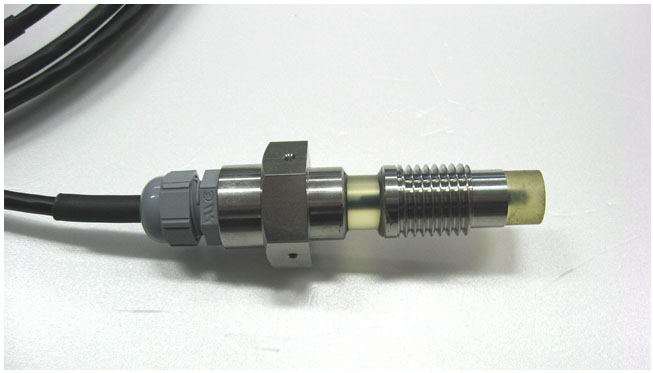 | Figure 1. The Simple smart bolt sensor |
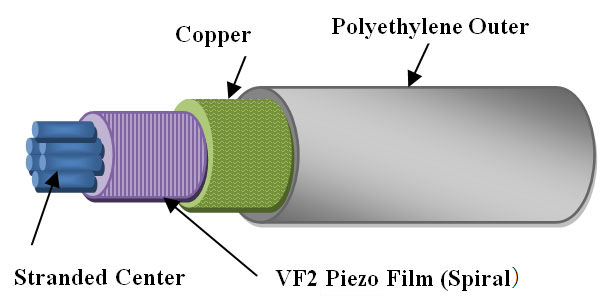 | Figure 2. Piezoelectric cable sensor (9) |
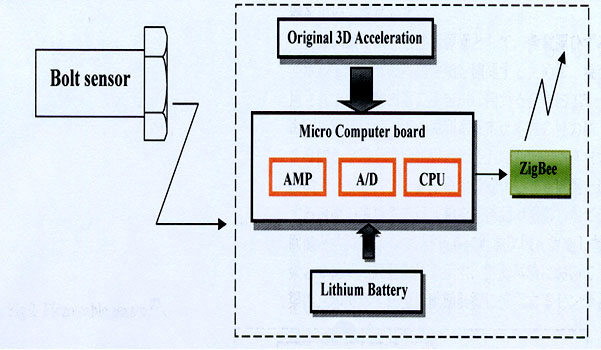 | Figure 3. Block diagram of the experimental system |
2.2. Sensor Installation and Measurement Method
- In general, small vibration and small displacements of bridges are measured by means of high precision devices like accelerometers, laser displacement transducers, optical fibre, etc. These measurements have an error of the order of 5 µm which represents a high precision measurement. In the case of the proposed sensor which is intended to be used for continuous real time health monitoring, the piezoelectric core cable of the bolt sensor emits a signal that corresponds to a change of the voltage when the bolts suffers a deformation. To permit the bolt to experiment a deformation it must be installed in the target structure inside a hole and then fixed by a nut. In principle, the change in voltage corresponds to a shear deformation of the bolt. Figure 4 shows the general layout of the vibration test of the bolt sensor using a small shaking table machine. Figure 5 shows a detail of the installation of the smart bolt sensor which is subjected to a shear deformation induced by the vibration devices. The test was performed at fixed amplitude and therefore it is supposed that the sensors behave under a fixed harmonic force. For comparison displacement of the vibration machine was measured by mean of a laser displacement transducer.
 | Figure 4. General layout of the vibration test |
 | Figure 5. Detail of the bolt sensor setup for vibration test |
 | Figure 6. Selected bridge and location of the point for measurements |
3. Discussion of Results
- In the case of vibration test the results for 0.5 mm of peak to peak amplitude and constant frequency of 2 Hz is shown in Figure 7. The figure shows the results obtained by the laser displacement transducer compared with the results from the bolt sensor. Good correlation can be observed from both results and the vibration characteristic is also clearly detected by the proposed simple smart bolt sensor.Vibration test were performed for 0.25 mm, 0.5 mm and 1 mm of amplitude respectively.For each amplitude value the frequency was set up from 1 Hz to 15 Hz. The curves that relate the frequency, amplitude and the maximum output voltage of the sensor are shown in Figure 8.
 | Figure 7. Comparison of measurement results from laser displacement transducer with those obtained from proposed smart bolt sensor during vibration test |
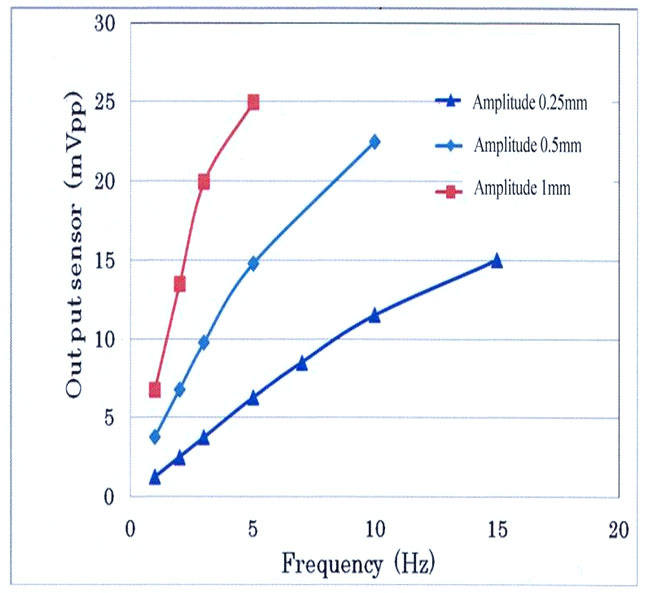 | Figure 8. Relationship between frequency, output voltage of sensor and amplitudeof the vibration |
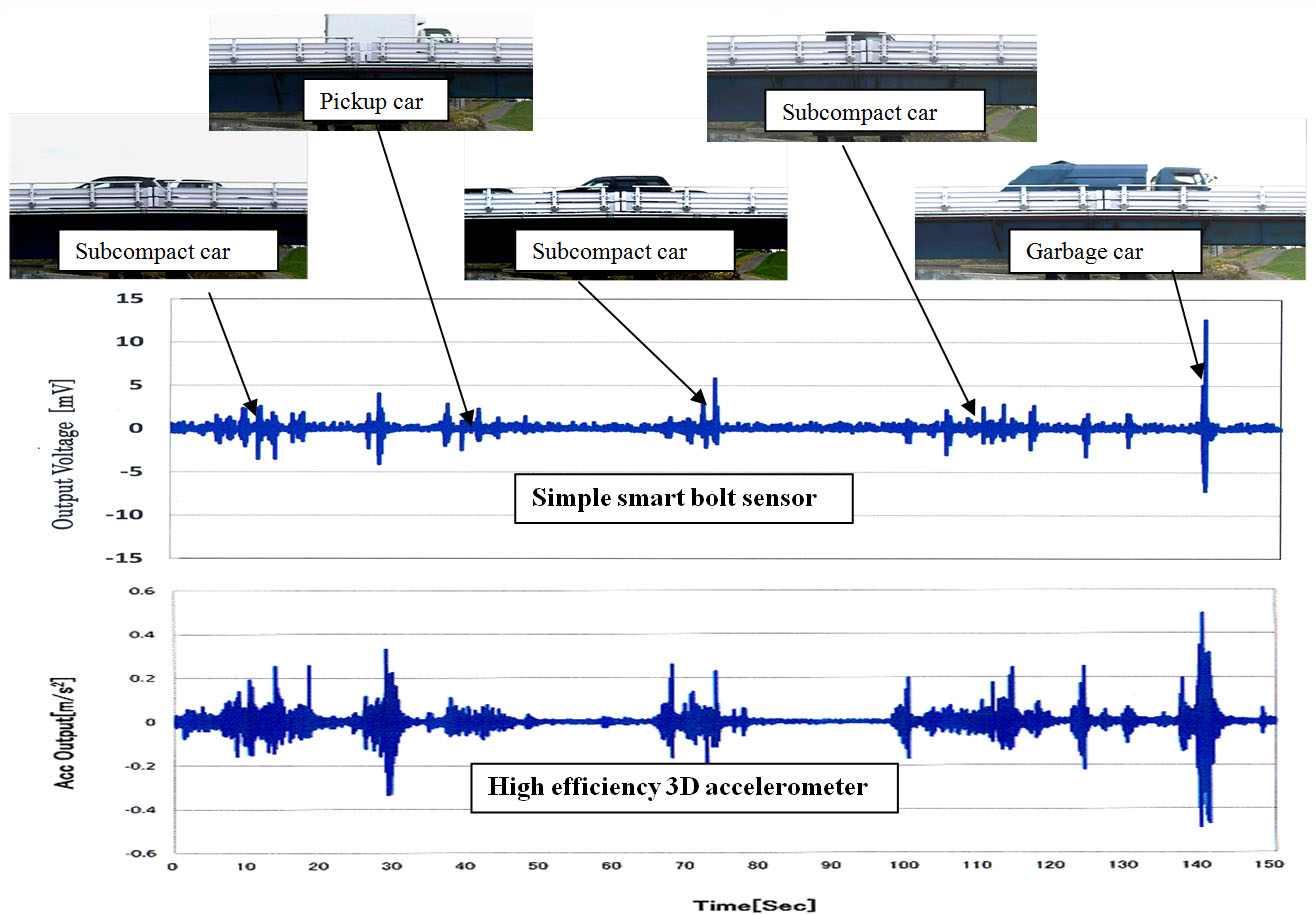 | Figure 9. Comparison of measurement results from simple smart bolt sensor with those obtained from high efficiency 3D accelerometer during structural monitoring of a bridge |
- From Figures 7 and 8 the following relationships between the output voltage of the sensor and the amplitude of vibration are obtained.
 | (1) |
 | (2) |
4. Conclusions
- To investigate the structural condition of bridges or any other structure, usually high precision or high performance measurement devices are employed. However, these devices are expensive and carefully handle must be taken into account since they are delicate instruments to be used for a permanent or long term monitoring. In this research a new smart simple piezoelectric sensor and its corresponding data acquisition system were developed to be used for real time structural health monitoring of structures. Installation of the system in selected portion of structures would permit to perform the monitoring of the structural condition, in special after an earthquake event and in the case of bridges to investigate their behaviour under vehicle loads and to detect potential failures due to ageing.Proposed strain bolt sensor was installed in a joint of a temporary bridge and measurements of the output voltage have permitted to infer the amplitude and frequency of the vibration and therefore to obtain the dynamic characteristics of the structures under investigation.The response of the proposed sensor for different type of vehicles passing the bridges is similar to that detected by means of high sensitivity accelerometers. Therefore the applicability of the proposed sensor and measurement system was verified.
ACKNOWLEDGEMENTS
- The authors acknowledge Akita Prefectural University President Project for the support of the Special Research on Battery Less Sensor for Structure Health Monitoring, under which this research was conducted.
 Abstract
Abstract Reference
Reference Full-Text PDF
Full-Text PDF Full-Text HTML
Full-Text HTML